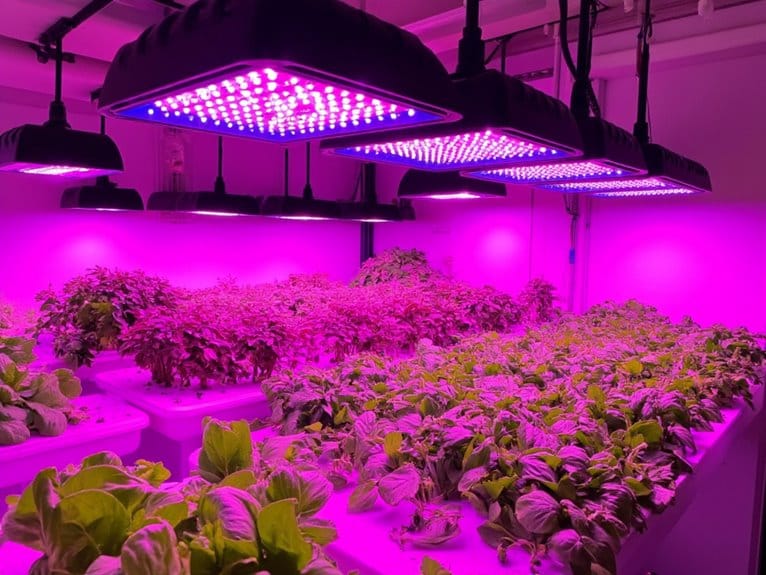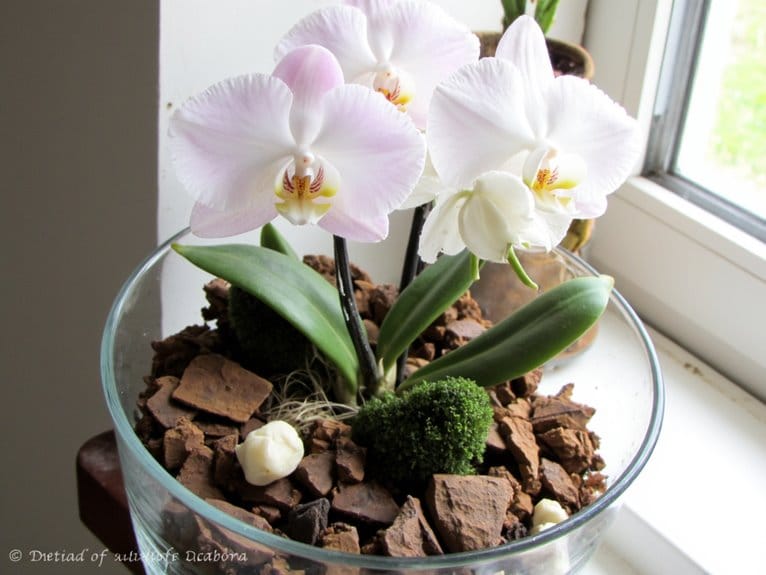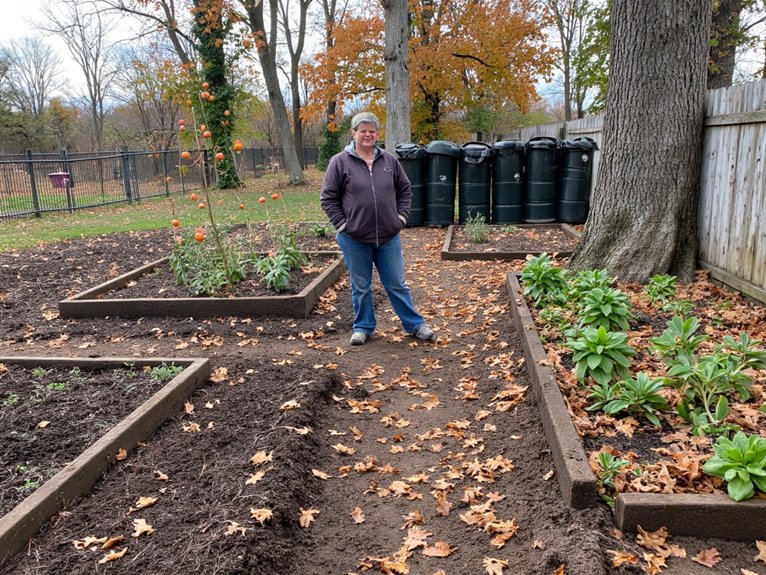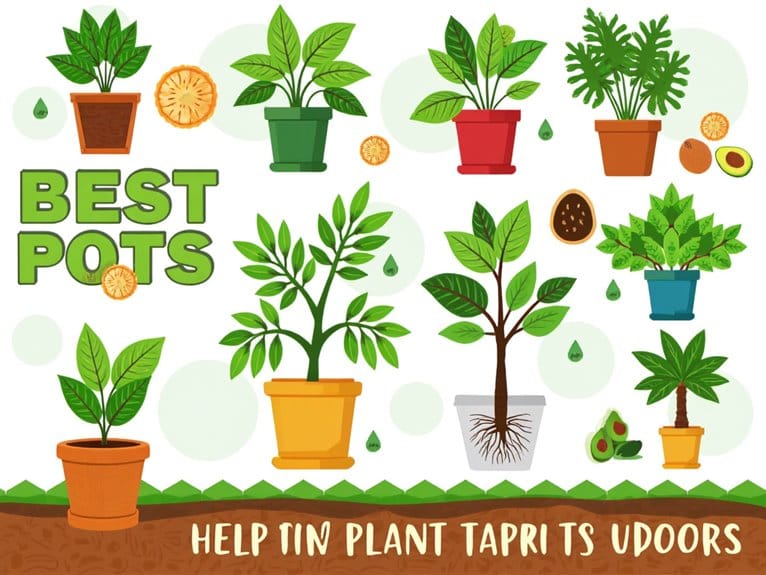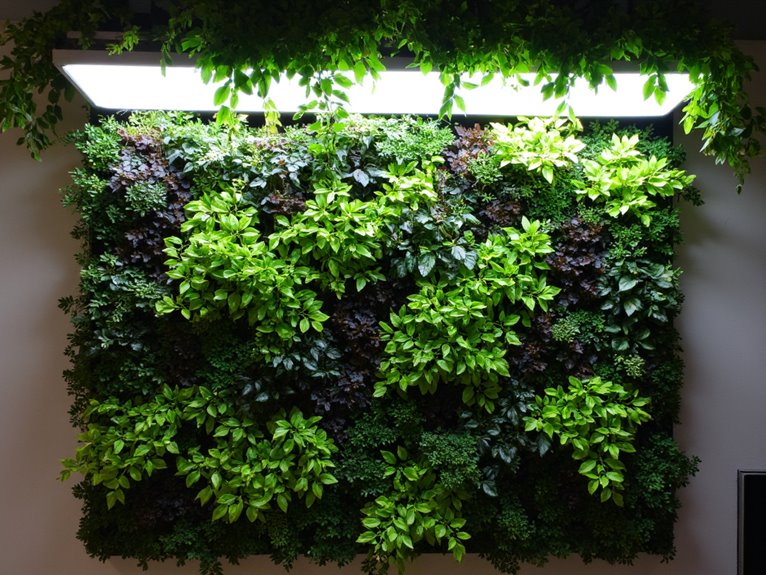Fertilizing Tropical Houseplants: Feeding Your Indoor Jungle for Lush Growth
To grow lush tropical houseplants, start by choosing the right fertilizer—liquid for quick boosts, granular for established plants, or organic for slow-release nutrition. Feed every 2-4 weeks in spring/summer and less frequently in fall/winter. Always water before applying to prevent burning, and consider foliar feeding for direct nutrient absorption. Yellowing leaves may signal nitrogen deficiency, while purple foliage suggests phosphorus needs. With proper feeding and care, your indoor jungle will thrive—discover more techniques to keep plants vibrant and healthy.
Notable Insights
- Choose balanced NPK liquid fertilizers for quick growth boosts during tropical houseplants’ active seasons.
- Apply diluted fertilizer every 2–4 weeks in spring/summer, reducing to monthly in fall/winter for steady nutrition.
- Use organic amendments like worm castings to create nutrient-rich soil and improve moisture retention naturally.
- Monitor for yellowing leaves (nitrogen) or brown edges (potassium) to identify deficiencies and adjust feeding accordingly.
- Combine sphagnum moss with coir for consistent dampness, enhancing the growing medium for tropical plants’ vibrant growth.
Choosing the Right Fertilizer for Tropical Houseplants
Choosing the right fertilizer for tropical houseplants depends on your plant’s needs and growing conditions. Liquid fertilizers work well for quick growth boosts during active seasons, while granular options suit larger-rooted plants like citrus trees. Organic choices offer steady nutrition and soil benefits, making them great for sensitive tropics, whereas synthetic formulas provide immediate results but require careful application to avoid burning. Fertilizer selection tips often hinge on balancing nitrogen (for leaves), phosphorus (for blooms), and potassium (for overall health). Nutrient balance strategies mean avoiding excesses that could harm your plants. Proper fertilization supports critical growth processes like root development, flowering, and leaf production, ensuring your tropical collection thrives with vibrant energy. Modern automated watering solutions can complement your fertilization routine by ensuring consistent moisture levels that help nutrients reach your plants effectively.
Fertilization Frequency: Timing Matters for Indoor Plants
When choosing how often to feed your tropical houseplants, consider their growth stage and seasonal rhythms rather than sticking to a rigid schedule. As plant growth accelerates in spring and summer, fertilize every 2–4 weeks for foliage plants like Monstera or Philodendron. Reduce to monthly feeding in fall and winter when growth slows. Seasonal adjustments are key—orchids may need weekly feeding during bloom, while succulents often require minimal nutrients. Always water before applying fertilizer to prevent burn, and flush soil periodically to remove salt buildup. Look for slow-release fertilizers that provide consistent feeding for 3-6 months to reduce the guesswork in fertilization schedules. Observe your plants closely; yellowing leaves might signal under- or over-fertilization. Maintain a tracking system to guarantee consistency without stress.
When adjusting your fertilization schedule, remember that seasonal growth patterns significantly impact nutrient needs—reducing feeding during colder months aligns with natural plant rhythms.
Effective Application Methods for Nutrient Delivery
Whether you’re nurturing a vibrant Monstera or cultivating delicate orchids, the way you deliver nutrients can make all the difference in your tropical houseplants’ health. Soil amendments like worm castings create natural nutrient reservoirs, while water-based fertilizing at diluted strengths (1/4 to 1/2 tsp per gallon) supports consistent nutrient timing. Slow-release pellets offer steady feeding aligned with indoor growing cycles, and foliar feeding provides a direct route for plants to absorb nutrients through leaves. Liquid fertilizers provide the fastest results with precise nutrient control, making them ideal for weekly feeding schedules. Balanced nutrition is particularly critical for tropical species, as their growth patterns often require precise nutrient ratios to maintain resilience and vibrant foliage.
Identifying Nutrient Deficiencies in Your Plants
You might notice your plants looking off – leaves that should be lush and green taking on strange colors or shapes – when what they really need is a closer look at their nutrient levels. Learning to recognize symptom patterns helps you diagnose issues early. For instance, yellowing old leaves suggest nitrogen deficiency while young ones turning yellow point to iron lack.
| Nutrient | Symptom Pattern | Diagnosis Techniques |
|---|---|---|
| Nitrogen | Yellowing old foliage | Use high-nitrogen fertilizer |
| Potassium | Brown edges, leaf holes | Root media supplementation |
| Phosphorus | Purple leaves, slow growth | Adjust light and temperature |
| Calcium | Curling new growth | Apply calcium nitrate |
| Magnesium | Yellow between green veins | Foliar Epsom salt spray |
Check for environmental stressors too. With practice, you’ll transform worry into wonder as your indoor jungle thrives!
Avoiding Fertilizer Errors That Harm Plants
While overfertilizing might seem like a way to show your plants some extra love, it’s actually one of the most common mistakes gardeners make that can seriously harm their green companions. Overfertilization symptoms like scorched leaf edges and weak stems signal fertilizer burn caused by salt buildup in soil. Underfertilization signs such as yellowing leaves and stunted growth reveal nutrient deficiencies weakening plant health. To avoid these errors, dilute fertilizers properly, flush pots regularly to prevent salt accumulation, and follow species-specific guidelines. Tropical plants often benefit from consistent feeding during their growing season with balanced formulations. Always water thoroughly after applying fertilizer to prevent root burn, and watch for early symptoms to adjust your approach before damage occurs. By learning these principles, you’ll keep your indoor jungle thriving without making common fertilizing mistakes.
Organic vs. Synthetic Fertilizers for Tropical Species
Have you ever wondered whether your tropical houseplants might be getting the right kind of nourishment? Organic fertilizers offer gentle, slow-release nutrition through compost, banana peels, and fish emulsion, improving soil structure and microbial health—key for tropics’ organic-rich needs. Their lower NPK ratios reduce burn risks and salt buildup, making them safer for sensitive species. Synthetic options provide quick growth with precise nutrient control but carry over-application dangers and may degrade soil biology long-term. While organic feeding supports steady development, synthetic methods can create lush blooms but demand careful monitoring. Choose based on your plants’ needs: organic for sustainability, or synthetics for targeted growth—just be mindful of their risks.
Fertilizing Plants Under Artificial Grow Lights
Whether you’re growing tropics under grow lights or in natural sun, their nutrient needs stay consistent, but artificial lighting changes how often you should feed them. Plants under poor light won’t benefit from extra fertilizer alone—you need to adjust both nutrition and illumination. When using grow lights, place them 12-24 inches from foliage to avoid burning, and fine-tune light intensity adjustment based on species requirements. Most tropics thrive with 12 hours of full-spectrum light daily. Fertilize every 1-2 weeks during active growth with a balanced NPK formula like Dyna-Gro Grow or Bloom Juice for flowering plants. Always dilute properly to prevent root burn, and pair feeding with ideal light placement for best results—your indoor jungle will reward the effort!
Building Soil Health With Natural Amendments
Building soil health for tropical houseplants isn’t just about throwing in compost—it’s about thoughtfully selecting amendments that match each plant’s unique needs. Organic matter like worm castings improves soil structure and boosts moisture retention, while perlite enhances drainage. For plants requiring consistent dampness, sphagnum moss or coir can maintain ideal conditions without waterlogging. Biochar not only enriches tilth but also supports microbial life essential for nutrient uptake. By blending these natural amendments, you create a dynamic growing medium that evolves over time, providing your indoor jungle with the foundation it needs to thrive.
Frequently Asked Questions
How Do I Choose the Best Fertilizer for My Specific Tropical Plant Species?
Figure out your plant’s specific needs and pick a fertilizer with matching nutrient ratios. Check labels for nitrogen, phosphorus, and potassium levels. Organic options work well for slow growth, while synthetics give quick boosts. Always follow application instructions to avoid burning your plants.
Is There a Safe Way to Use Compost Directly on Tropical Houseplants?
Yes, you can use compost directly on tropical houseplants by applying a thin layer on top of soil rather than mixing it in, which supports tropical plant health without risking nutrient imbalances or root burn. Just make sure it’s well-finished!
Can I Fertilize During Hot Summer Months Without Causing Stress?
You can fertilize during hot summer months with care – focus on Fertilizer timing, use diluted formulations to avoid burning, and apply when plants are coolest. Monitor closely for Summer stress signs like browning.
What Signs Indicate My Plant Needs More Potassium Than Nitrogen?
What signs indicate your plant needs more potassium than nitrogen? Burnt leaf edges with green veins suggest potassium deficiency rather than nitrogen’s uniform yellowing. Check for brown spots or purple hues—these point to potassium issues needing better nutrient balance.
Are Coffee Grounds Beneficial or Harmful for Tropical Plant Soil?
You should consider both coffee ground benefits and risks when adding them to tropical plant soil. They offer nutrients and improve drainage but can cause waterlogging if overused. Find balance to keep your indoor jungle healthy.
On a final note
With the right care and knowledge, your tropical houseplants can thrive and transform your space into a lush indoor jungle. Remember to choose the proper fertilizer, feed on schedule, and apply with care to watch your plants grow stronger and more vibrant. By understanding their needs and avoiding common mistakes, you’ll enjoy healthier, flourishing greenery that brings life and beauty to your home. Keep learning and experimenting—your indoor garden thanks you!

